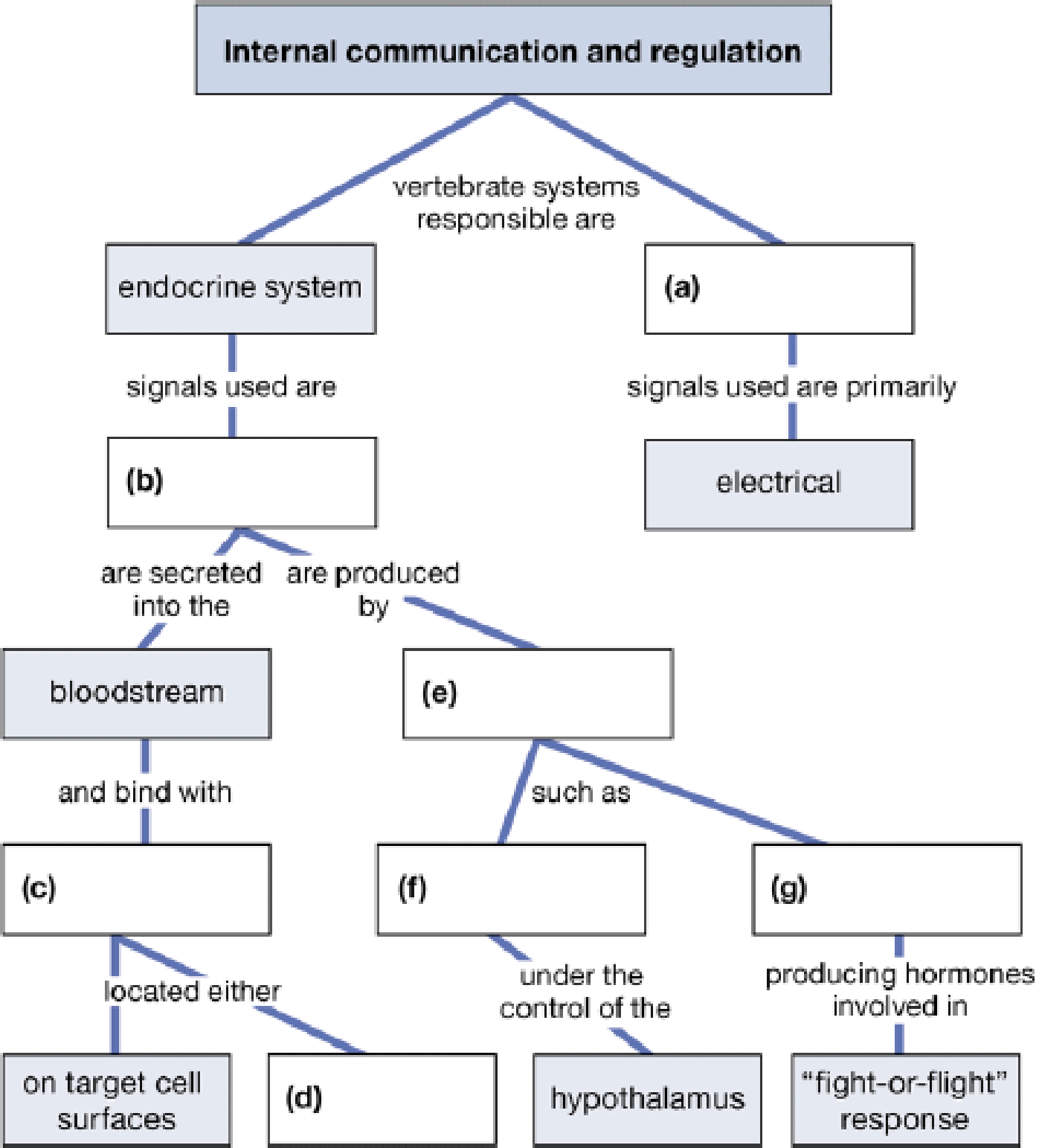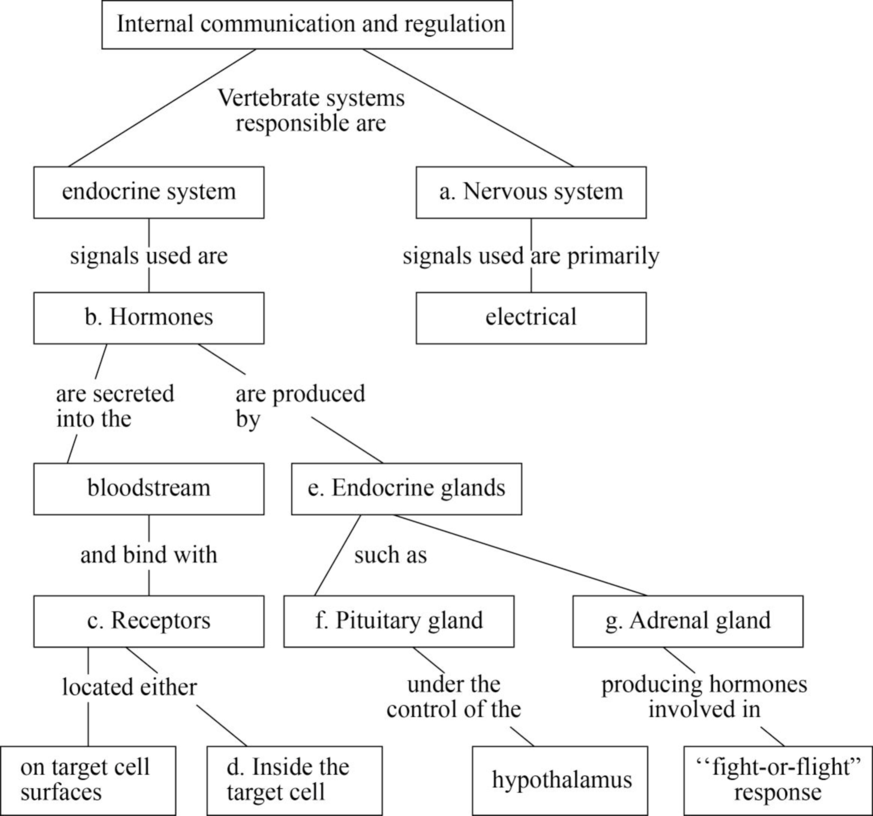
Concept explainers
Complete this map, which presents some major concepts from this chapter.

To complete: The given map that shows the internal communication and regulation.
Introduction: There are two major ways of internal regulation and communication. These are regulated by hormones (chemical substances) and neuronal communication (electrical signals). Neuronal regulation is carried out by neurons either electrically or by the help of neurotransmitters. Hormonal regulation is carried out by hormones that are usually peptides or steroid molecules.
Answer to Problem 1CC
Pictorial representation: Fig. 1 represents the chart of the internal communication and regulation by hormones in vertebrates.

Fig. 1: Internal communication and regulation.
Explanation of Solution
(a)
Correct answer: Nervous system
The nervous system is the organ system of the body, which conducts nerve impulses in the form of electrical signals that pass along the dendrites to generate an action potential. Hence, the correct answer is nervous system.
(b)
Correct answer: Hormones
Hormones are the chemical substances that are secreted by a special group of cells or tissues called the endocrine glands. They pour their secretions into the bloodstream. The exocrine glands are also found in our bodies, which pour their secretions in a tube or a duct. Hence, the correct answer is hormones.
(c)
Correct answer: Receptors
Receptors are the structures that are mostly made up of proteins whose function, as the name suggests, is that they receive the signals or the chemicals or hormones and thereby transmit or elicit a response in the cell on which they are present. Hence, the correct answer is receptors.
(d)
Correct answer: Inside the target cell
Receptors are present inside or outside the cell. They receive the hormones that are secreted by the endocrine glands. Their functioning is regulated either by the hormone itself or by some other biomolecules. Hence, the correct answer is inside the target cell.
(e)
Correct answer: Endocrine glands
Hormones are the chemical substances or biomolecules that are secreted or formed by the endocrine cells. The chemical substances that are formed by the exocrine glands are called secretions. Secretions are poured into a tube or a duct, whereas the hormones are secreted directly into the bloodstream. Hence, the correct answer is endocrine glands.
(f)
Correct answer: Pituitary gland
The pituitary gland is also called the master gland as it controls the functioning of all the other endocrine glands. However, this gland is also regulated by the hypothalamus, which is a part of the brain. Hence, the correct answer is pituitary gland.
(g)
Correct answer: Adrenal gland
The adrenal gland is also called the suprarenal gland as it is located above the kidneys. It secretes a hormone called adrenaline, which is also called the 3F hormone or the emergency hormone as this provides the support for the response that is needed in emergency conditions like fighting or in fearful conditions. Hence, the correct answer is adrenal gland.
Want to see more full solutions like this?
Chapter 26 Solutions
CAMPBELL BIO: CONCEPTS&CONNECTIONS (LL)
- Describe and give a specific example of how successionary stage is related to species diversity?arrow_forwardExplain down bellow what happens to the cell in pictures not in words: Decreased pH in mitochondria Increased ATP Decreased pH in cytosol Increased hydrolysis Decreasing glycogen and triglycerides Increased MAP kinase activity Poor ion transport → For each one:→ What normally happens?→ What is wrong now?→ How does it mess up the cell?arrow_forward1.) Community Diversity: The brown and orange line represent two different plant communities. a. Which color represents the community with a higher species richness? b. Which color represents the community with a higher species evenness? Relative abundance 0.1 0.04 0.001 2 4 6 8 10 12 14 16 18 20 22 24 Rank abundance c. What is the maximum value of the Simpson's diversity index (remember, Simpson's index is D = p², Simpson's diversity index is 1-D)? d. If the Simpson's diversity index equals 1, what does that mean about the number of species and their relative abundance within community being assessed?arrow_forward
- 1.) Community Diversity: The brown and orange line represent two different plant communities. a. Which color represents the community with a higher species richness? b. Which color represents the community with a higher species evenness? Relative abundance 0.1 0.04 0.001 2 4 6 8 10 12 14 16 18 20 22 24 Rank abundance c. What is the maximum value of the Simpson's diversity index (remember, Simpson's index is D = p², Simpson's diversity index is 1-D)? d. If the Simpson's diversity index equals 1, what does that mean about the number of species and their relative abundance within community being assessed?arrow_forwardwhat measures can a mother to take to improve the produce of her to milk to her newborn baby ?arrow_forward1. Color the line that represents all ancestors of the Eastern white pine tree green (but only the ancestral line NOT shared with other organisms) 2. Oncle the last common ancestor of the Colorado blue spruce tree and Eastern white pine tree. 3. Put a box around the last common ancestor of the sugar maple tree and the dogwood tree. 4. Put a triangle around the last common ancestor of the red pine tree and the american holly bush. 5. Color the line that represents all ancestors of the Ponderosa pine tree red (including all shared ancestors). 6. Color the line that represents all ancestors of the American elm tree blue (including all shared ancestors). 7 Color the line that represents all ancestors of the Sabal palm tree purple (including all shared ancestors) 8. Using a yellow highlighter or colored pencil, circle the clade that includes all pine trees. 9. Using a orange highlighter or colored pencil, circle the clade that includes all gymnosperms 10. Can you tell…arrow_forward
- You have been hired as a public relations specialist to give invertebrates a good name. After all, they are much more than just creepy crawly bugs! Your first task though is to convince yourself that is true. The best way to do that is to start close to home. Find something in your house that is a product obtained directly from an invertebrate or only due to an invertebrate’s actions. Describe the product, its function and utility, as well as any human manufactured alternatives. Be sure to highlight the advantages of obtaining this directly from nature. Keep in mind, a product can be something you use, wear, eat, or enjoy for its visual appeal.arrow_forwardUse the following tree diagram to answer Questions #8-10. 8) Which of the following two animals are the most closely related based on the tree to the left? a) Pig and camel b) Hippo and pig c) Deer and cow 9) CIRCLE on the tree diagram where the common ancestor between a hippo and a cow is. 10) Put a SQUARE on the tree diagram where the common ancestor between a pig and a peccary is.arrow_forwardExplain: Healthy Cell Function Overview→ Briefly describe how a healthy cell usually works: metabolism (ATP production), pH balance, glycogen storage, ion transport, enzymes, etc. Gene Mutation and Genetics Part→ Focus on the autosomal recessive mutation and explain: How gene mutation affects the cell. How autosomal inheritance works. Compare the normal and mutated gene sequences simply. → Talk about possible consequences of a faulty hydrolytic enzyme.arrow_forward
- Can you fill out those termsarrow_forwardExplain down bellow what happens to the cell: Decreased pH in mitochondria Increased ATP Decreased pH in cytosol Increased hydrolysis Decreasing glycogen and triglycerides Increased MAP kinase activity Poor ion transport → For each one:→ What normally happens?→ What is wrong now?→ How does it mess up the cell?arrow_forwardAn 1100 pound equine patient was given 20 mg/kg sucralfate 3 times a day, 2.8 mg/kg famotidine twice a day, and 10mg/kg doxycycline twice a day. Sucralfate comes as a 1 gm tablet, famotidine as 20 mg tablets, and doxycycline as 100mg tablets. All are in bottles of 100 tablets.How many total mg are needed for the patient and how many tablets of each would be needed to provide each dose?How many bottles of each would be needed to have available if this patient were to be on this drug regimen for 5 days?arrow_forward
- Health Safety And Nutrition F/Young ChildHealth & NutritionISBN:9781305144767Author:MAROTZPublisher:Cengage
 Biology Today and Tomorrow without Physiology (Mi...BiologyISBN:9781305117396Author:Cecie Starr, Christine Evers, Lisa StarrPublisher:Cengage LearningCase Studies In Health Information ManagementBiologyISBN:9781337676908Author:SCHNERINGPublisher:Cengage
Biology Today and Tomorrow without Physiology (Mi...BiologyISBN:9781305117396Author:Cecie Starr, Christine Evers, Lisa StarrPublisher:Cengage LearningCase Studies In Health Information ManagementBiologyISBN:9781337676908Author:SCHNERINGPublisher:Cengage  Biology (MindTap Course List)BiologyISBN:9781337392938Author:Eldra Solomon, Charles Martin, Diana W. Martin, Linda R. BergPublisher:Cengage Learning
Biology (MindTap Course List)BiologyISBN:9781337392938Author:Eldra Solomon, Charles Martin, Diana W. Martin, Linda R. BergPublisher:Cengage Learning





